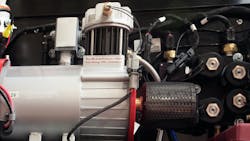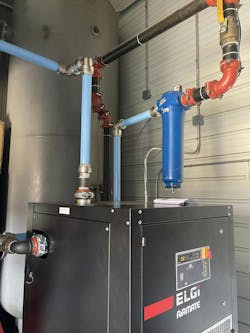Why Dryers and Filters are Critical to Air Compressor System Health
Key Highlights
- Dryers and filters are vital for maintaining compressed air quality and protecting downstream equipment.
- Recognizing the signs of premature dryer or filter failure, such as pressure drop, is necessary to prevent potential downtime issues from occuring.
- Proper sizing and regular maintenance of filters and dryers is vital to ensuring long-term compressed air system performance.
Air compressor systems are an important part of many industrial operations as they supply the pressurized air necessary to operate various machines and their components such as valves. Ensuring these systems continue to operate as desired is critical to maintaining productivity.
This is where dryers and filters enter the picture. These two components play an integral role in keeping air compressor systems running as smoothly as possible. Although they may not receive as much attention as an air compressor itself, dryers and filters help prevent moisture, oil and particulates from getting into compressed air and causing damage to machines and components.
In this Q&A with Justin Beckett, Technical Field Specialist at ELGi, he explains the importance of dryers and filters in maintaining the health of air compressor systems, how these technologies work and common performance issues that can occur if these components are overlooked.
Why do dryers and filters matter so much in an air compression system?
Justin Beckett: Air compressors get most of the attention, but they’re only part of the equation. Dryers and filters are essential for ensuring air quality, protecting downstream equipment and maintaining reliable performance. If these components fail or aren’t properly maintained, the result can be costly: equipment damage, production delays and even lost contracts in sensitive industries like food, beverage and pharmaceuticals.
Is it necessary for air compressor systems to include both dryers and filters to ensure optimal performance? If so, how do the two technologies work together to ensure smooth operation?
Justin Beckett: Yes, and the extent depends on the quality of air your production requires. Without dryers and filters, water, oil and particulates are carried downstream into equipment and processes.
Air compressors naturally produce moisture which must be removed to prevent interference with production. Moisture separators and drains eliminate bulk water while a dryer lowers the dewpoint of the air. At the same time filters remove particulates, oil and other contaminants concentrated from the ambient air during compression. Without proper filtration, equipment can suffer from clogging, corrosion and scaling. Even small amounts of oil carryover can compromise a desiccant dryer leading to costly repairs.
What are the different types of dryers and filters that are commonly used with air compressor systems and what are the important factors to consider when determining which type to use?
Justin Beckett: The two most common dryers are Refrigerated Air Dryers and Desiccant Air Dryers:
- Refrigerated dryers are well-suited for most general industrial applications and typically achieve a dewpoint around 38 F (3.33 C) when properly sized.
- Desiccant dryers are used in sensitive applications requiring very low dewpoints.
Selection depends on the required ISO air quality class for the process. Correct sizing is critical, so expert consultation is recommended.
What are some of the most common problems you see with filters?
Justin Beckett: One of the first signs something’s wrong is a pressure drop — for example, you’re only getting 100 psi at the application point instead of 120. A common reaction is to raise the compressor pressure, which overworks the system and increases energy use. If the filter becomes clogged or ruptures, it can allow oil, dirt and water into the system. That contamination damages equipment and affects air quality.
How can companies avoid pressure drop and premature filter or dryer failure?
Justin Beckett: It starts with proper maintenance and sizing. Filters need to be inspected and replaced at scheduled intervals. If a filter clogs early, it could indicate a problem inside the compressor, like oil carryover. Sizing is equally important; you can’t just match the dryer and filter to your compressor’s CFM (cubic feet per minute) rating which indicates how much air is moved per minute through the compressor. You also have to factor in ambient temperature, pressure and altitude. Otherwise, you’re setting the system up for pressure loss even when the dryers and filters are clean.
Besides pressure drop, are there other signs to look for to determine if there is a problem with a filter and it may need to be replaced?
Justin Beckett: Filters can eventually fail or become contaminated. For example, a coalescing filter that becomes saturated with water will no longer function properly and will lower air quality. In some cases, filters may rupture after prolonged pressure drop creating the false impression that airflow has improved while in reality the system is running unprotected.
What about dryers – what are some of the key signs that may indicate there is a problem with a dryer?
Justin Beckett: Problems usually show up downstream. Excessive moisture, sweating pipes or rising dewpoint readings all indicate dryer performance issues. Central monitoring systems can help by identifying abnormal dewpoint trends early and allowing problems to be addressed before production is affected.
What risks are associated with dryers and how can companies manage them?
Justin Beckett: Dryers remove moisture from compressed air, which is critical to avoid corrosion, scaling and damage to tools and electronics. Desiccant dryers, which are used in environments that demand very dry air, are especially vulnerable. If oil or water contaminates the desiccant beds, they lose effectiveness and are expensive to replace. That’s why proper filtration upstream of the dryer is so important. In fact, many dryer manufacturers require filtration to keep warranty coverage intact.
Is there a way to proactively prevent all these issues?
Justin Beckett: Yes — service agreements with a trusted air compressor distributor make a big difference. Regular inspections and maintenance help catch problems before they escalate. It’s an investment that often pays for itself by avoiding unplanned downtime. This is especially important for smaller businesses that don’t have backup compressors or parts. When something breaks, the whole operation can grind to a halt.
How frequently should the dryers and filters of an air compressor system be inspected and what should personnel be looking for during these inspections to ensure larger problems do not occur at a later date?
Justin Beckett: End users should perform quick daily checks for leaks, alarms, unusual sounds, abnormal readings or dirty coolers. Service providers should conduct a full inspection at least twice a year depending on runtime. Preventive maintenance requirements such as oil sampling for warranty coverage should also be followed.
Any final advice for companies trying to protect their compressed air systems?
Justin Beckett: Don’t wait until something breaks to take filters and dryers seriously. These components are easy to forget — until a system fails and the costs start adding up. With proper sizing, filtration and maintenance, you can avoid a lot of headaches down the line.
Learn more about ELGi’s Justin Beckett
Justin Beckett is a Technical Field Specialist with nearly a decade of experience in the compressed air industry. He has held roles in technical support, field service, and training — specializing in electrical controls and troubleshooting. Justin previously served as a technician and trainer for ELGi’s industrial business and now supports customers across multiple regions through his work with Pattons, part of the ELGi group of companies.
About the Author
Sara Jensen
Executive Editor, Power & Motion
Sara Jensen is executive editor of Power & Motion, directing expanded coverage into the modern fluid power space, as well as mechatronic and smart technologies. She has over 15 years of publishing experience. Prior to Power & Motion she spent 11 years with a trade publication for engineers of heavy-duty equipment, the last 3 of which were as the editor and brand lead. Over the course of her time in the B2B industry, Sara has gained an extensive knowledge of various heavy-duty equipment industries — including construction, agriculture, mining and on-road trucks —along with the systems and market trends which impact them such as fluid power and electronic motion control technologies.
You can follow Sara and Power & Motion via the following social media handles:
X (formerly Twitter): @TechnlgyEditor and @PowerMotionTech
LinkedIn: @SaraJensen and @Power&Motion
Facebook: @PowerMotionTech

Leaders relevant to this article:




